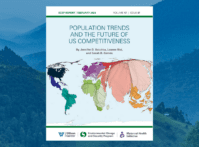Last week, the
World Wildlife Fund (WWF) hosted “Agriculture, Land Use, and Climate: Implications for African Development,” a panel discussion on agriculture’s essential current and future role in Africa’s development. As panelist Martin Bwyala of the
New Partnership for African Development (NEPAD) noted at the beginning of the discussion, 60 to 70 percent of the population of sub-Saharan Africa depends on agriculture or another form of direct land use for their livelihoods. “Africa’s foundation for sustainable growth lies in enhancing the productivity and sustainable use of its natural resources,” said Bwyala. The panel highlighted the adverse effects of unsustainable land use and climate change on Africans’ livelihoods, and examined the merits of potential solutions.
The panelists emphasized that governments and NGOs are better positioned to aid Africa today than ever before, and that the Comprehensive Africa Agriculture Development Programme (CAADP) provides an important opportunity to do so. A joint venture by the UN Food and Agriculture Organization (FAO) and NEPAD, with the support of other agencies, CAADP is “a manifestation of African governments’ commitment to address issues of growth in the agricultural sector, rural development and food security,” FAO’s website explains. [w1] The panelists’ overwhelming consensus was that NGOs and governments can and should collaborate to pursue CAADP’s goals, which include: achieving an annual agricultural production growth rate of 6 percent; strengthening domestic and international markets for African agricultural products; spending at least 10 percent of annual public expenditure on agricultural investment; and expanding sustainable management of land and water resources.
Elaborating on CAADP’s goals, Arati Belle of the World Bank explained precisely what is at stake in increasing the sustainability of African agriculture. 485 million Africans are adversely affected by land degradation, which is not surprising, she said, considering that 30 percent of Africa’s GDP and 70 percent of its employment come from the agricultural sector. The goal of the TerrAfrica initiative, launched at the CAADP Partnership Forum, is to “scale up the effectiveness and efficiency of sustainable land management in sub-Saharan Africa.” The need for sustainable land management couldn’t be more urgent: On average, soil and nutrient loss cause a 3 percent annual reduction in African countries’ GDP, said Belle. Citing the Intergovernmental Panel on Climate Change, Belle warned that unless sustainable and adaptive solutions are implemented, declining crop productivity and increasing variability in precipitation over the course of this century are likely to exacerbate the agricultural sector’s woes.
Continuing this line of reasoning, WWF’s David Reed argued that agencies, governments, and companies involved in Africa “have to change the very base case of their investments, calculations, and thinking, particularly in the agricultural sector.” When thinking about the future of African agriculture, it is crucial to incorporate the impacts of the continent’s massive population growth, said Reed, because the 15 million sub-Saharan Africans who enter the labor market each year are likely to move predominantly into agriculture. It is important that NGOs help African countries take advantage of this influx of labor, Reed said, by promoting agro-forestry best practices, working with agricultural ministries, and encouraging more diverse production systems at the household and community levels.
The final panelist was Angel Elias-Daka of the Common Market for Eastern and Southern Africa (COMESA), who used statistics—as well as anecdotes from his 20 years working in the wetlands of Zambia and Malawi—to shed light land degradation in Africa. Elias-Daka’s field experiences showed him that millions of people depend heavily on wetlands that—due to climate change and unsustainable use—are drying up and losing their biodiversity. He explained the link between COMESA’s work in the region and Africa’s agricultural production as follows: “If you promote trade and investment and people are able to trade their agricultural products, you are also going to promote agricultural production because people know they can trade their agricultural products easily.” Sustainable agricultural development will serve both the economic and the environmental needs of the continent, said Elias-Daka.  A Publication of the Stimson Center.
A Publication of the Stimson Center.






